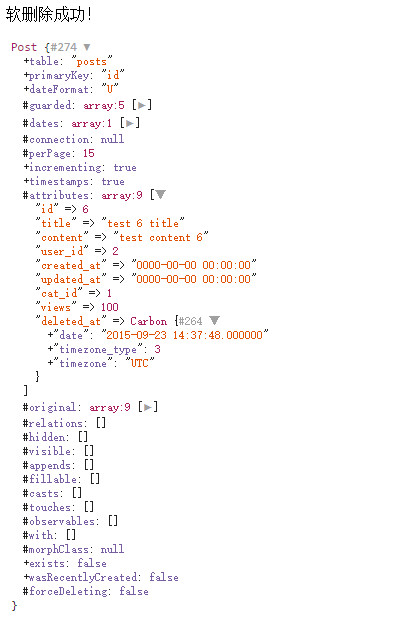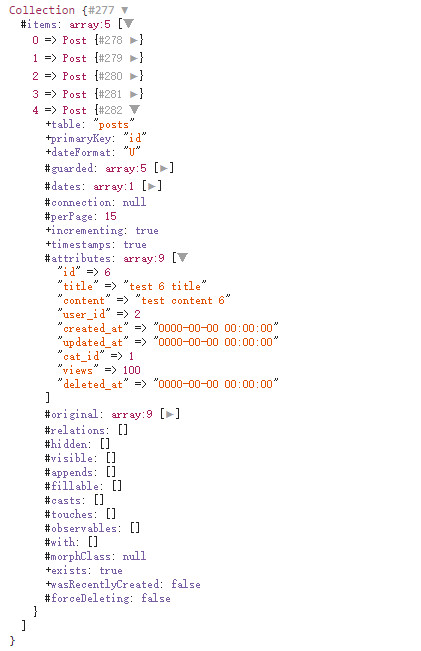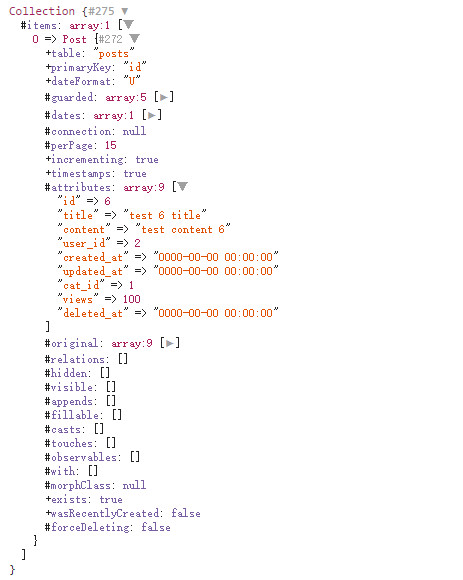Eloquent ORM 实例教程 —— 模型删除及软删除相关实现
1、删除模型
1.1 使用delete删除模型
删除模型很简单,先获取要删除的模型实例,然后调用delete方法即可:
$post = Post::find(5);
if($post->delete()){
echo '删除文章成功!';
}else{
echo '删除文章失败!';
}
该方法返回true或false。
1.2 使用destroy删除模型
当然如果已知要删除的模型id的话,可以用更简单的方法destroy直接删除:
$deleted = Post::destroy(5);
你也可以一次传入多个模型id删除多个模型:
$deleted = Post::destroy([1,2,3,4,5]);
调用destroy方法返回被删除的记录数。
1.3 使用查询构建器删除模型
既然前面提到Eloquent模型本身就是查询构建器,也可以使用查询构建器风格删除模型,比如我们要删除所有浏览数为0的文章,可以使用如下方式:
$deleted = Models\Post::where('views', 0)->delete();
返回结果为被删除的文章数。
2、软删除及其相关实现
2.1 软删除实现
上述删除方法都会将数据表记录从数据库删除,此外Eloquent模型还支持软删除。
所谓软删除指的是数据表记录并未真的从数据库删除,而是将表记录的标识状态标记为软删除,这样在查询的时候就可以加以过滤,让对应表记录看上去是被”删除“了。Laravel中使用了一个日期字段作为标识状态,这个日期字段可以自定义,这里我们使用deleted_at,如果对应模型被软删除,则deleted_at字段的值为删除时间,否则该值为空。
要让Eloquent模型支持软删除,还要做一些设置。首先在模型类中要使用SoftDeletestrait,该trait为软删除提供一系列相关方法,具体可参考源码Illuminate\Database\Eloquent\SoftDeletes,此外还要设置$date属性数组,将deleted_at置于其中:
<?php
namespace App\Models;
use Illuminate\Database\Eloquent\Model;
use Illuminate\Database\Eloquent\SoftDeletes;
class Post extends Model
{
use SoftDeletes;
//设置表名
public $table = 'posts';
//设置主键
public $primaryKey = 'id';
//设置日期时间格式
public $dateFormat = 'U';
protected $guarded = ['id','views','user_id','updated_at','created_at'];
protected $dates = ['delete_at'];
}
然后对应的数据库posts中添加deleted_at列,我们使用迁移来实现,先执行Artisan命令:
php artisan make:migration alter_posts_deleted_at --table=posts
然后编辑生成的PHP文件如下:
<?php
use Illuminate\Database\Schema\Blueprint;
use Illuminate\Database\Migrations\Migration;
class AlterPostsDeletedAt extends Migration
{
/**
* Run the migrations.
*
* @return void
*/
public function up()
{
Schema::table('posts', function (Blueprint $table) {
$table->softDeletes();
});
}
...//其它方法
}
然后运行:
php artisan migrate
这样posts中就有了deleted_at列。接下来,我们在控制器中编写测试代码:
$post = Post::find(6);
$post->delete();
if($post->trashed()){
echo '软删除成功!';
dd($post);
}else{
echo '软删除失败!';
}
在浏览器中访问http://laravel.app:8000/test,页面输出如下:

当我们再次通过下面这段代码获取所有文章:
$posts = Post::all(); dd($posts);
已经看不到id为6的文章的身影了。
2.2 查询结果包含软删除模型
那如果想要在查询结果中包含软删除的记录呢?可以使用SoftDeletes trait上的withTrashed方法:
$posts = Post::withTrashed()->get(); dd($posts);
执行之后页面显示如下:

id为6的文章又出现在了查询结果中。有时候我们只想要查看被软删除的模型,这也有招,通过SoftDeletes上的onlyTrashed方法即可:
$posts = Post::onlyTrashed()->get(); dd($posts);
执行后页面显示结果如下:

2.3 软删除恢复
有时候我们需要恢复被软删除的模型,可以使用SoftDeletes提供的restore方法:
恢复单个模型
$post = Post::find(6); $post->restore();
恢复多个模型
Post::withTrashed()->where('id','>',1)->restore();
恢复所有模型
Post::withTrashed()->restore();
恢复关联查询模型
$post = Post::find(6); $post->history()->restore();
2.4 强制删除
如果模型配置了软删除但我们确实要删除改模型对应数据库表记录,则可以使用SoftDeletes提供的forceDelete方法:
$post = Post::find(6); $post->forceDelete();
查看数据表可以发现id=6的表记录已经被删除,不复存在:

该方法也支持关联模型强制删除,我们后面讲到关联关系的时候再具体说明。


29 Comments
Lavarel的框架,一些理念可以学习。